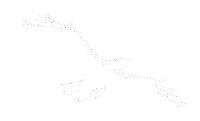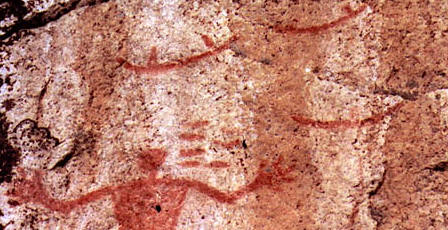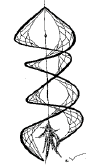Tradition says that many generations ago, all the
different clans of the tribe, with the exception of the Ah-ahwank, formed a
league and made war on the Aw-aus-e with the intent to exterminate them. But
the Aw-aus-e family proved too strong for their united brethren and
prevailed against their efforts, and ever since this event, they have
claimed a certain pre-eminence over them in the councils of the tribe. They
also claim, that of the six beings who emerged from the great water, and
originated the Totems, their progenitor was the first who appeared, and was
leader of the others.Of nine thousand of the
Ojibways who reside within the limits of the United States, about the shores
of Lake Superior and the headwaters of the Mississippi, full one thousand
belong to the Aw-aus-e family.
The Bus-in-as-see, or Crane family, are also numerous, and
form an important element of the Ojibway tribe. They reside mostly on the
south shores of Lake Superior and toward the east in the Canadas, though
they have representatives scattered in every spot where the Ojibways have
set foot and lighted their fires. The literal meaning of their totemic name
is, "Echo-maker," derived from the word Bus-wa-wag, "Echo," and pertaining
to the loud, clear, and far reaching cry of the Crane. This clan are noted
as possessing naturally a loud, ringing voice, and are the acknowledged
orators of the tribe; in former times, when different tribes met in
councils, they acted as interpreters of the wishes of their tribe. They
claim, with some apparent justice, the chieftainship over the other clans of
the Ojibways. The late lamented chief Shin-ga-ba-wos-sin, who resided at
Sault Ste. Marie, belonged to this family. In Gov. Lewis Cass's treaty at
Prairie du Chien in 1825, he was the acknowledged head chief of his tribe,
and signed his name to that treaty as such. Ahmous (the Little Bee), the son
of the late worthy chief of Lac du Flambeau, Waub-ish-gaug-aug-e (or White
Crow), may now be considered as head or principal chief of this family.
The old war chief Ba-be-sig-aun-dib-ay (Curly Head), whose
name is linked with the history of his tribe, and who died on his way
returning home from the Treaty of Prairie du Chien above mentioned, was also
a Bus-in-aus-e, and the only representative of his clan amongst that section
of his tribe, who so long bravely struggled With the fierce Dakotas for the
mastery of the western banks of the Mississippi, which now form the home of
the Winnebagoes. He was the civil and war chief of the Mississippi Ojibways.
Hole-in-the-day 1st, of later notoriety, and his brother Song-uk-um-ig
(Strong ground), inherited his chieftainship by his dying request, as he
died childless. Weesh-e-da-mo, son of Aissance (Little Clam), late British
Ojibway chief of Red River, is also a member of this family. He is a young
man, but has already received two American medals, one from the hands of a
colonel of our army, and the other from the hands of the Governor of
Minnesota Territory. He is recognized by our government as chief of the
Pembina section of the Ojibway tribe.
These facts are stated to show the importance of this
family, and its wide extended influence over the tribe. It can be said of
them that wherever they have planted their wigwam on the widespread
territory of their people, they have been recognized as chieftains.
They also boast the names of Keesh-ke-mun, chief of the
Lac du Flambeau section; Che-suh-yauh and Waub-ij-e-jauk (White Crane), of
La Pointe, Shaug-a-waum-ik-ong, all noted chiefs during their first
intercourse with the white race.
The small clans who use the eagle as their Totem or badge,
are a branch of the Bus-in-aus-e.
The Ah-ah-wauk, or loon totem, also form an important body
in the Ojibway tribe; in fact, they also claim to be the chief or royal
family, and one of their arguments to prove this position is that nature has
placed a color [collar?] around the neck of the loon, which resembles the
royal megis, or wampum, about the neck of a chief, which forms the badge of
his honor. This dignity, however, is denied by the Cranes and other totems,
who aver that the principal chiefs of the Ah-ah-wauk are descended from
individuals who were on a certain occasion made chiefs by the French at
Quebec, as will be related in the course of the following history. This
family do not lack in chiefs who have acted a prominent part in the affairs
of the tribe, and whose names are linked with its history.
Ke-che-waish-keenh (Great Buffalo), the respected and
venerable chief of the La Pointe band, and principal chief of all the Lake
Superior and Wisconsin bands, is the acknowledged head of this clan, and his
importance as an individual in the tribe, strengthens the position of the
Ah-ah-wauk. The chief of Sandy Lake on the upper Mississippi is also of this
family. The Goose and Cormorant Totems are its subdivisions. The No-ka or
Bear family are more numerous than any of the other clans of the Ojibways,
forming fully one-sixth of the entire tribe.
In former times this numerous body was subdivided into
really lesser clans, making only portions of the bear's body their Totems,
as the head, the foot, the ribs, etc. They have all since united under one
head, and the only shade of difference still recognized by them is the
common and grizzly bear. They are the acknowledged war chiefs and warriors
of the tribe, and are keepers of the war-pipe and war-club, and are often
denominated the bulwarks of the tribe against its enemies.
It is a general saying, and an observable fact, amongst
their fellows, that the Bear clan resembles the animal that forms their
Totem in disposition. They are ill tempered and fond of fighting, and
consequently they are noted as ever having kept the tribe in difficulty and
war with other tribes, in which, however, they have generally been the
principal and foremost actors. They are physically noted, and the writer has
observed the fact, that they are possessed of a long, thick, coarse head of
the blackest hair, which seldom becomes thin or white in old age. Young
Hole-in-the-day (son of the great war-chief of that name), the recognized
chief of the Ojibways of the Mississippi, numbering about twelve hundred, is
now [A.D. 1852] the most noted man of the No-ka family. Ka-kaik (the Hawk),
of Chippeway River, and Be-she-ke (Buffalo), of Leech Lake, have extolled
influence as war chiefs.
The Mah-een-gun, or Wolf totem family, are few in number,
and reside mostly on the St. Croix River and at Mille Lac. They are looked
upon by the tribe in general with much respect. The Ojibways of this totem
derive their origin on the paternal side from the Dakotas. Na-guon-abe. the
civil chief of Mille Lac, may be considered the principal man of this
family. Mun-o-min-ik-a-she (Rice-maker), who has lately removed from the St.
Croix to Mille Lac with his band, is a man of considerable importance
amongst his fellows.
The Waub-ish-a-she, or Marten family, form a numerous body
in the tribe, and is one of the leading clans. Tradition says that they are
sprung from the remnant captives of a fierce and warlike tribe whom the
coalesced Algie tribes have exterminated, and whom they denominate the
Mun-dua. The chiefs Waub-ish-ash (the Marten), of Chippeway River, Shin-goob
(Balsam), and Nug-aun-ub (Sitting-ahead), of Fond du Lad, are now the
principal men of the clan. The celebrated Ke-che-waub-ish-ash, of Sandy
Lake, Sha-wa-ke-shig, of Leech Lake, and Muk-ud-a-shib (or Black Duck), of
Red River, were members of this family. In their days they conduced greatly
towards wresting country from the Dakotas, and driving them westward. All
three died on battle-fields--the first at Elk River fight, the second at Rum
River massacre, and the third fell fighting on the western prairies against
immense odds; but one out of forty, who fought with him, escaped a warrior's
death.
Under the generic term of Mous-o-neeg, the families of the
Marten, Moose, and Reindeer totems are included. Aish-ke-bug-e-coshe, the
old Pillager chief, related to me the following tradition, accounting for
the coalition or close affinity between the Moose and Marten totems:--
"The family of the Moose totem, denominated Mous-o-neeg, many centuries ago,
when the Ojibways lived towards the rising sun, were numerous and powerful.
They lived congregated by themselves in one great village, and were noted
for their warlike and quarrelsome disposition. They were ill tempered and
proud of their strength and bravery. For some slight cause they commenced to
make war on their brethren of the Marten totem. Severely suffering from the
incursions, and unable to cope singly with the Mous-o-neeg, the Martens
called together the different clans of the tribe to council, and called on
them for help and protection. A general league was made between the
different totems, and it was determined that the men of the obnoxious and
quarrelsome family of the Moose badge should be exterminated.
"The plan for their sudden and total destruction was
agreed upon, and a council lodge was ordered to be built, which was made
narrow and just long enough to admit all the warriors of the Mous-o-neeg.
The poles of this lodge were planted firmly and deep in the ground, and
close together, and lapping over the top they were strongly twisted and
fastened together. Over this frame were tied lengthways, and worked in like
wicker-work, other green poles, and so close together that a man's hand
could scarcely pass through any part of the frame, so close and strong was
it constructed. Over this frame, and from the inside, leaving but a long
narrow aperture in the top, was fastened a thick covering and lining of
dried grass.
"When this lodge had been completed, runners were sent to
the village of the Moose Totem family, and all their chiefs and warriors
solemnly invited to a national council and feast. This summons was made in
such a manner that they could not refuse, even if they so felt disposed; and
on the day fixed, the chiefs and all the men of war of the refractory clan
arrived in a body at the village of their mortal foes (the Martens), where
the council-lodge had been built and made ready.
"They were led into the lodge, where the old men and
chiefs of the tribe had collected to receive them. The Mous-o-neeg entered
unarmed, and as their great numbers gradually filled the lodge, the former
inmates, as if through courtesy, arose and went out to give them room.
Kettles full of cooked meat were brought in and placed before them, and they
were requested to eat, after the fatigues of their journey. They entirely
filled the long lodge; and when every one had left it but themselves, and
while they were busy feasting on the good things that had been placed before
them, the doors at each end were suddenly closed and fastened on them. A
chief of the Marten Totem then addressed them in a loud voice, repeating
over all the acts of blood and wickedness, which they had enacted, and
informing them that for these things the national council had decreed to
sweep them from the face of the earth which they polluted. The lodge was
surrounded by the warriors of the Marten, who acted as executioners; torches
were applied to the thick and dry covering of grass, and, struggling in the
flames unable to escape, the men of the Moose Totem were dispatched with
barbed arrows shot through the narrow openings between the lodge-poles that
confined them. In this fearful manner were the men of this wicked clan
destroyed. Their women and children were captured by the Marten family, and
adopted into their clan. In this manner the close consanguinity of these two
Totems commenced, and at this day they are considered as one family."
The Reindeer family, which is a branch of the Mous-o-neeg,
are few in number, and they reside mostly on the north coast of Lake
Superior. The celebrated Ojibway war-leader Waub-o-jeeg (White Fisher), whom
Mr. Schoolcraft has noticed in his writings at some length, was a member of
this family, descended from a branch who emigrated from the Grand Portage
near the mouth of Pigeon River to La Pointe, Shag-a-waum-ik-ong, where he
and his father, Ma-moug-e-se-do (Big-foot), flourished nearly a century ago
as war-leaders and chiefs of their people.
The other badges or totemic symbols which I have
enumerated, form inconsiderable families, and are but branches of the
principal clans whom I have noticed in the foregoing pages.
It will be difficult, till a minute insight is obtained
into the totemic history and organization of all the Algic tribes, to decide
fully the number of generic or grand Totems, which are recognized among
them, and the numeric strength of each.
This subject is deserving of close research and study. I
consider it a most important link in solving the deep mystery, which covers
their origin. Even with the imperfect insight which has been given on this
subject by different writers, an analogy cannot but be noticed existing in
many respects between the totemic division of the Algics, and the division
of the Hebrews into tribes. And the remarkable purity with which the system
has been kept up for ages, finds no other parallel in the history of
mankind.
go to chapter 3
1
- 2
- 3
- 4
- 5
- 6
- 7
- 8
- 9
- 10
11
- 12
- 13
- 14
- 15
- 16
- 17
- 18
- 19
- 20
21
- 22
- 23
- 24
- 25 - 26 - 27 - 28 - 29 - 30
White Eagle Soaring: Dream Dancer of the 7th Fire







 Get
a course to promote your business online, explode your sales
Get
a course to promote your business online, explode your sales Get
software to promote your business online in less time
Get
software to promote your business online in less time Get
software to streamline your business and run it hands free.
Get
software to streamline your business and run it hands free.